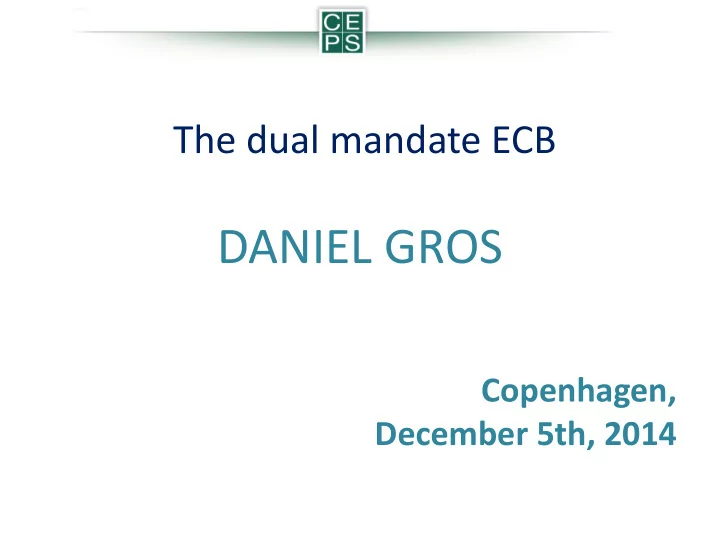

The dual mandate ECB DANIEL GROS Copenhagen, December 5th, 2014
The ECB has a dual mandate Price stability (below, but close to 2 % inflation). Keeping the euro area from disintegration (politically and economically). At present no trade off between the two.
Double challenge for ECB Preventing deflation might be difficult: on average euro area is becoming a ‘creditor economy’. Even unconventional monetary policy instruments might not work. Preventing disintegration: deflation might make adjustment too difficult in periphery with political risk of exit and return of crisis with high risk premia adding to the misery.
Reviewing the crisis from the point of view of the double challenge So far: From Maastricht to Greece to Japan. Next: ?.
Main refinancing operations- fixed rate 0,05 0,5 5 [CELLRANGE] [CELLRANGE] 0,1 [CELLRANGE] [CELLRANGE] [CELLRANGE] Standard Deviation in LT int. rate [CELLRANGE] [CELLRANGE] [CELLRANGE] [CELLRANGE] [CELLRANGE] [CELLRANGE] [CELLRANGE] 1 [CELLRANGE] [CELLRANGE] [CELLRANGE] 10
Japanese decade for the euro? Can ‘Japan’ for euro be avoided? QE might not work in euro area. Euro area bank based financial system, so lowering market rates might not have big impact (interest elasticity of investment anyway small and variable). Creditors lose income from lower rates and debtors might spend little of windfall (except governments). Higher asset prices (and rents) depress income of poorer, high spending propensity consumers.
Japanese decade for the euro? Would ‘Japan’ by sustainable in Europe? ‘Japan’ = zero interest rate + mild deflation => low positive real rates? Sustainable for periphery? Burden on public finances lower than during 1990s. Need for relative domestic price adjustment worsens debt dynamics near term, but this is limited (stock problem rather than eternal flow).
Snowball effect (g-i) not so bad under euro? DE IT Average 1994-2000 -2,6 -1,3 Average 2000-2007 -1,3 0,1 Average 2008-2014 0,3 -2,7 2014 December 2,9 0,7
Deflation: Main refinancing operations- fixed rate 0,05 0,5 5 [CELLRANGE] Break-up: Standard Deviation in LT int. rate 0,1 [CELLRANGE] [CELLRANGE] [CELLRANGE] [CELLRANGE] QE works? [CELLRANGE] [CELLRANGE] [CELLRANGE] [CELLRANGE] [CELLRANGE] [CELLRANGE] [CELLRANGE] 1 [CELLRANGE] [CELLRANGE] Deflation makes [CELLRANGE] debt burden 10
Last two decades lost for Japan? Nominal GDP stagnant, but since 1995 real GDP per working age population growth J = US = Europe! Secular stagnation (?) = need negative interest rate for full employment. Japan: unemployment not up, employment rate up. (Some employment might be ‘artificial’, but cannot explain why employment increases during ‘lost’ decades.) => No secular stagnation, not much potential for demand side policies to increase growth.
Activity Rates 88 86 JAPAN 84 % of population aged 15-64 82 80 USA 78 76 EU 74 72 70 1995 1996 1997 1998 1999 2000 2001 2002 2003 2004 2005 2006 2007 2008 2009 2010 2011 2012 2013 2014 2015 EU27 (EU15 up tp 1999) 74,2 74,3 74,4 74,6 74,8 75,1 75,2 75,2 75,3 76,0 76,2 76,4 77,2 77,5 77,6 77,7 USA 78,7 78,6 78,5 78,1 77,9 78,5 78,4 78,3 78,4 77,7 77,7 77,7 77,8 78,0 78,3 77,7 76,9 77,2 76,6 75,9 76,3 JAP 80,4 80,9 81,5 81,4 81,1 81,0 80,9 80,8 81,0 81,1 82,0 82,7 83,5 83,9 84,6 84,0 83,7 84,6 85,5 86,2 86,8
Participation rates key indicator • Japan: no significant labour ‘reserve’ left. • EU: overtakes US! • EU: trend increase in participation rates = sign of structural reforms or changing composition of labour force? • => more the latter, but implies Europe is wasting its human capital.
The tables are turning globally: Happy debtors grumpy creditors ‘Debtor nations’ more likely to deal quickly with a debt overhang than creditor nations: • Savers less powerful => more likely to go for inflation. • Net foreign debt large => nations gains from lower rates. • Insolvency procedures likely to be less punishing for debtors (e.g. no recourse) => easier to restructure debt if needed.
The unhappy euro area: debtors and creditors clash Euro area contains both ‘debtor ‘ and ‘creditor’ nations. But not necessarily with direct relationship: Spain (foreign debt) versus Italy (domestic debt). EDB can help Spain, but not Italy. => Difficult to fulfill dual mandate on both accounts.
Recommend
More recommend